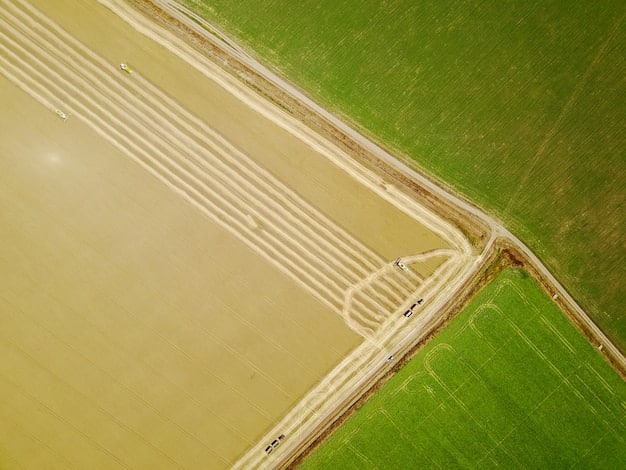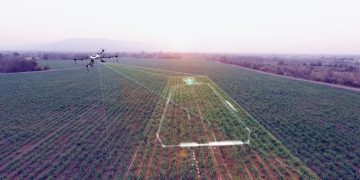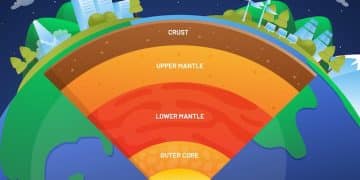Soil Health: Carbon Sequestration & Crop Production Boost

Advertisements
Enhancing soil quality through regenerative practices significantly boosts carbon sequestration, pulling atmospheric carbon dioxide into the ground, while simultaneously improving crop yields and fostering more resilient agricultural systems globally.
Advertisements
The intricate relationship between what lies beneath our feet and the health of our planet is often overlooked. However, understanding The Science of Soil Health: How Improving Soil Quality Can Increase Carbon Sequestration and Improve Crop Production is fundamental to addressing some of humanity’s most pressing environmental and agricultural challenges. This exploration delves into the biological, chemical, and physical dimensions of healthy soil, revealing its profound capacity to mitigate climate change and secure food supplies.
Advertisements
The Foundational Role of Soil in Ecosystems
Soil, far from being just inert dirt, is a living, breathing ecosystem teeming with unseen life and complex interactions. It provides the essential medium for plant growth, filters water, cycles nutrients, and plays a critical role in global carbon dynamics.
This dynamic environment is comprised of mineral particles, organic matter, water, and air, all interconnected in a delicate balance. The physical structure of soil, often referred to as its aggregation, influences water infiltration, aeration, and root penetration, directly impacting plant health and microbial activity.
Understanding Soil Structure and Composition
Soil structure is immensely important, determining how water and air move through the soil profile. Good soil structure, characterized by stable aggregates, allows for efficient water uptake by plants and reduces runoff and erosion.
- Mineral Content: Varies based on bedrock, providing essential nutrients.
- Organic Matter: Decomposed plant and animal residues, crucial for fertility and water retention.
- Pore Space: The empty spaces between particles, filled with air and water, vital for root respiration and microbial life.
The chemical properties of soil, such as pH, nutrient availability, and cation exchange capacity, dictate the solubility and accessibility of vital elements for plant absorption. A balanced chemical profile is necessary for thriving microbial communities and robust plant growth.
Biologically, soil is a microcosm of incredible diversity. Billions of microorganisms, including bacteria, fungi, protozoa, and nematodes, along with larger organisms like earthworms and insects, collectively drive nutrient cycling, decompose organic matter, and suppress plant diseases. This intricate web of life is the engine of soil health.
Carbon Sequestration: Soil’s Role in Climate Mitigation
One of the most compelling aspects of healthy soil is its immense potential as a carbon sink. Carbon sequestration is the process of capturing and storing atmospheric carbon dioxide, converting it into organic forms within the soil. This natural process offers a powerful solution for mitigating climate change.
Plants absorb CO2 from the atmosphere through photosynthesis, converting it into carbohydrates. A significant portion of these carbohydrates is allocated to root growth and the exudation of compounds into the soil, feeding the microbial community. When plants and microbes die, their carbon-rich organic matter becomes incorporated into the soil, building up what is known as soil organic carbon (SOC).
Mechanisms of Carbon Storage
Several mechanisms contribute to carbon storage in soil. The formation of stable soil aggregates protects organic matter from rapid decomposition. Soil type, climate, and management practices all influence the rate and stability of carbon sequestration.
- Microbial Cycling: Microbes convert plant residues into more stable forms of organic matter.
- Root Exudates: Sugars and other compounds released by roots feed soil microbes, leading to carbon incorporation.
- Physical Protection: Organic matter becomes trapped within soil aggregates, protecting it from breakdown.
Agricultural practices that promote soil health, such as no-till farming, cover cropping, and diversified rotations, significantly enhance carbon sequestration by increasing the input of organic matter and minimizing disturbance. These practices foster a rich environment where carbon can be effectively stored over long periods, directly reducing greenhouse gas concentrations in the atmosphere.
The potential for soil to sequester carbon is enormous. Estimates suggest that agricultural soils globally could sequester billions of tons of carbon per year if managed regeneratively, making it a vital strategy alongside emissions reductions.
Improving Crop Production Through Healthy Soil Practices
Beyond climate mitigation, healthy soil is the bedrock of productive agriculture. Restoring and maintaining soil health directly translates into higher, more resilient crop yields, reducing the need for external inputs and contributing to more sustainable food systems.
Healthy soil provides a stable and fertile environment for plant roots, ensuring efficient uptake of water and nutrients. The improved soil structure facilitates deeper root penetration, making plants more resilient to drought and extreme weather events. Furthermore, vibrant microbial communities enhance nutrient cycling, making essential elements more available to crops and improving overall plant vigor.
Key Practices for Enhanced Productivity
Adopting specific farming techniques can dramatically improve soil quality, leading to better crop outcomes. These practices prioritize minimizing disturbance and maximizing organic matter inputs.
- No-Till Farming: Reduces soil disturbance, preserving soil structure and organic matter.
- Cover Cropping: Plants grown between cash crops, protecting soil, adding organic matter, and suppressing weeds.
- Crop Rotation: Diversifies plant types, breaking pest cycles and improving nutrient cycling.
The reliance on synthetic fertilizers and pesticides can be significantly reduced, or even eliminated, in healthy soil systems. Biologically active soils naturally provide nutrients to plants and suppress pests and diseases, lowering production costs and environmental impact. This shift towards soil-centric agriculture promotes a more harmonious and productive relationship between farming and nature.
Investing in soil health is an investment in long-term agricultural productivity and food security. It’s a move away from extractive practices towards a regenerative approach that builds natural capital.

Regenerative Agriculture: A Holistic Approach
Regenerative agriculture encompasses a set of farming principles and practices that aim to restore and enhance ecosystem health, particularly soil health. It moves beyond sustainable practices to actively rebuild degraded natural resources.
The core tenets of regenerative agriculture include minimizing soil disturbance, maximizing crop diversity, keeping the soil covered, maintaining a living root year-round, and integrating livestock. These principles work synergistically to enhance the biological activity of the soil.
Core Principles and Benefits
The adoption of regenerative practices leads to a cascade of benefits, both for the farm and the wider environment. Beyond carbon sequestration and improved yields, these methods foster greater biodiversity and water quality.
- Minimal Soil Disturbance: No-till or reduced tillage preserves soil structure and microbial networks.
- Crop Diversity: Polycultures and diverse rotations improve soil biology and nutrient cycling.
- Continuous Living Roots: Cover crops and perennial systems keep roots in the ground, feeding microbes.
By promoting a thriving soil microbiome, regenerative practices enhance the natural resilience of farming systems. Soils become more resistant to erosion, better able to retain water during droughts, and more efficient at cycling nutrients. This robustness reduces risks for farmers and creates a more stable food supply.
The philosophy of regenerative agriculture is one of healing and rebuilding. It recognizes that healthy food comes from healthy soil, and that regenerating our soils is crucial for the well-being of both people and the planet.
Challenges and Opportunities in Soil Health Adoption
While the benefits of improving soil quality are clear, the transition to widespread adoption of soil-health-focused practices faces several challenges. These include economic, educational, and systemic barriers that need to be addressed.
For farmers, the initial investment in new equipment, the learning curve associated with different practices, and the perceived risks of shifting away from conventional methods can be deterrents. Policy frameworks and market incentives often favor conventional, input-intensive agriculture, making it challenging for regenerative farmers to compete.
Overcoming Barriers to Adoption
Addressing these challenges requires a multi-faceted approach involving education, financial support, and policy changes. Collaborative efforts among researchers, policymakers, farmers, and consumers are essential.
- Education & Training: Providing farmers with accessible knowledge and practical skills in soil health practices.
- Financial Incentives: Government programs and private initiatives offering subsidies or reduced insurance premiums for adopting regenerative methods.
- Market Demand: Growing consumer demand for sustainably produced food can drive market shifts.
Despite these hurdles, significant opportunities exist. The increasing awareness of climate change and environmental degradation is creating a powerful impetus for change. Innovative technologies, such as precision agriculture tools, can support the transition by providing data-driven insights into soil health. Furthermore, direct-to-consumer models and niche markets for regeneratively grown products are emerging.
The opportunity lies in transforming agriculture from a source of environmental degradation into a powerful engine for ecological restoration and climate solutions. This demands a collective shift in mindset and investment.
Future Perspectives: Research, Innovation, and Policy
The future of soil health is bright, driven by ongoing research, technological innovation, and evolving policy frameworks. Advancements in our understanding of soil biology and chemistry are continually revealing new ways to optimize soil functions.
Research is focusing on developing better methods for measuring soil carbon, understanding complex microbial interactions, and breeding crops that better interact with soil ecosystems. This scientific progress informs the development of more effective and scalable soil health practices.
Key Areas of Focus
Several areas are particularly active in driving the future of soil health. Digital tools and genetic advancements promise to accelerate progress.
- Advanced Soil Monitoring: Remote sensing and in-situ sensors provide real-time data on soil health.
- Microbial Inoculants: Developing and applying beneficial microbes to enhance soil functions.
- Genetic Engineering: Breeding crops with enhanced root systems or symbiotic relationships with soil organisms.
Policy initiatives play a crucial role in accelerating the adoption of soil-health-improving practices. Carbon markets that reward farmers for sequestering carbon, subsidies for cover crops, and revised crop insurance programs can create strong incentives. International agreements and national strategies that prioritize soil health as a climate solution are also gaining traction.
Education at all levels, from agricultural universities to extension services and farmers’ networks, is vital for disseminating knowledge and fostering a community of practice around soil health. By combining cutting-edge science with practical application and supportive policies, we can unlock the full potential of soil to nourish our planet and feed future generations.

| Key Point | Brief Description |
|---|---|
| 🌱 Soil as Ecosystem | Soil is a living system crucial for plant growth, water filtration, and nutrient cycling, supporting diverse microbial life. |
| 🌍 Carbon Sink Potential | Healthy soil sequesters atmospheric CO2 as organic carbon, offering a powerful climate change mitigation strategy. |
| 🍎 Crop Productivity Boost | Improved soil quality leads to higher, more resilient crop yields and reduced need for synthetic inputs. |
| 🌾 Regenerative Practices | No-till, cover cropping, and crop rotation are key methods for rebuilding soil health and ecosystem functions. |
Frequently Asked Questions About Soil Health
▼
Soil organic carbon (SOC) is the carbon component of soil organic matter, derived from decomposed plant and animal residues. It is vital because it improves soil structure, water retention, nutrient availability, and acts as a significant reservoir for atmospheric carbon dioxide, playing a crucial role in climate regulation.
▼
Healthy soil, rich in organic matter and with good structure, significantly improves water infiltration and retention. This reduces runoff and erosion, minimizes water waste, and makes crops more resilient to drought periods by ensuring water is available to plant roots for longer, optimizing water use efficiency.
▼
While regenerative agriculture alone cannot reverse climate change, it is a powerful tool in mitigating it. By actively sequestering carbon from the atmosphere into the soil, it reduces greenhouse gas concentrations. Combined with drastic reductions in fossil fuel emissions and other climate solutions, it contributes significantly to climate stability.
▼
Soil biodiversity, encompassing a vast array of microorganisms and invertebrates, is fundamental to soil health. These organisms drive nutrient cycling, decompose organic matter, build soil structure, and suppress plant diseases. A diverse soil ecosystem fosters resilience and productivity, creating a self-sustaining environment for plant growth.
▼
The timeline for soil health improvements varies





